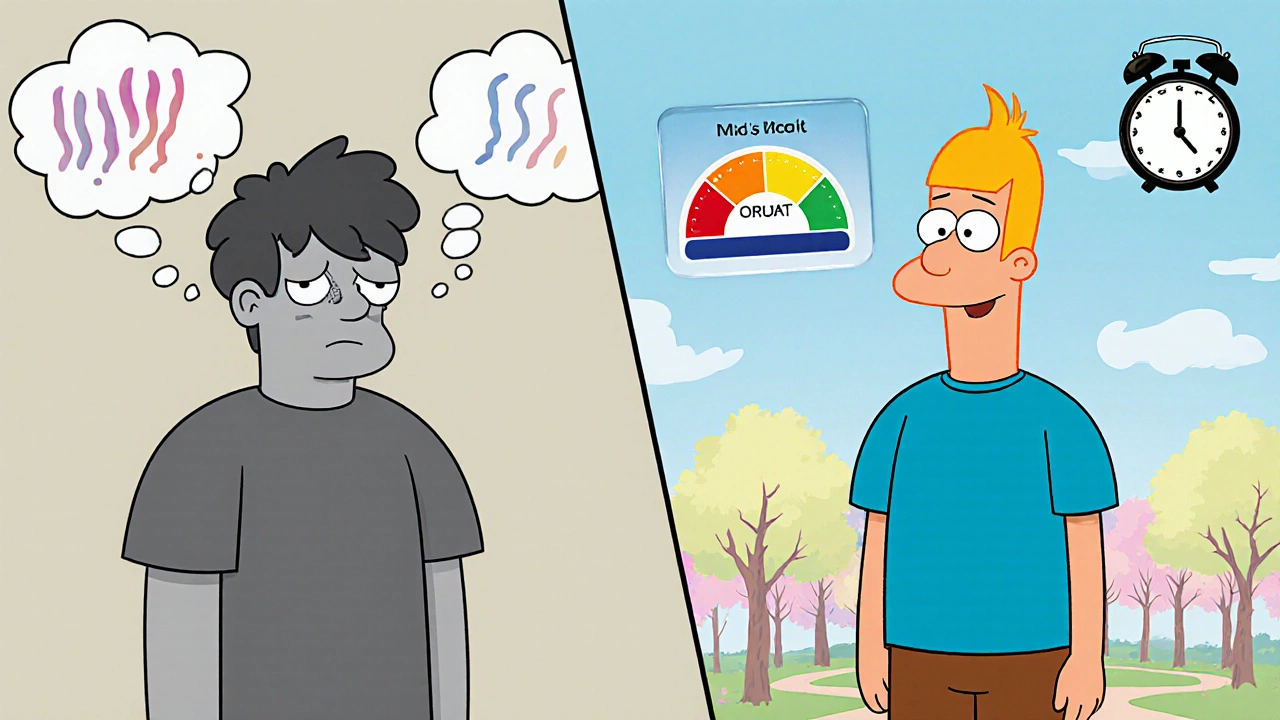Lurasidone Weight Gain Comparison Tool
Understand Your Weight Gain Risk
Based on clinical studies in over 2,500 participants, Lurasidone shows significantly lower weight gain than many other antipsychotics. This tool estimates your potential weight change with Lurasidone versus other medications.
Weight Change Estimate
Comparison with Lurasidone
Starting Lurasidone could reduce your potential weight gain by compared to your current medication.
How This Works
Based on clinical evidence:
- Lurasidone shows average weight change of less than 1 kg after 12 weeks
- Other antipsychotics like Olanzapine often add 3-5 kg over the same period
- Individual results vary based on metabolism, dosage, and other factors
- Weight gain risks decrease with Lurasidone due to minimal metabolic impact
When treating mental health conditions, Lurasidone is an atypical antipsychotic approved for schizophrenia and bipolar depression. It received its first FDA approval in 2010 and works by modulating dopamine D2 and serotonin 5‑HT2A receptors, giving it a unique side‑effect profile compared with older drugs.
Why Lurasidone Stands Out
Many patients on antipsychotics struggle with weight gain, metabolic syndrome, and sedation. Lurasidone has a lower propensity for weight gain and metabolic disturbances than drugs like olanzapine or clozapine. Clinical trials in over 2,500 participants show an average weight change of less than 1 kg after 12 weeks, while comparable agents often add 3-5 kg.
How It Works: The Science Behind the Drug
The medication’s primary action is Dopamine D2 receptor antagonism, which reduces psychotic thinking. At the same time, it partially agonizes Serotonin 5‑HT2A receptor to improve mood and cognitive function. This dual mechanism is why it works for both psychosis (schizophrenia) and mood disorders (bipolar depression).
Key Benefits for Schizophrenia patients
- Rapid reduction of positive symptoms such as hallucinations and delusions.
- Improvement in negative symptoms (social withdrawal, flat affect) when combined with psychosocial therapy.
- Lower risk of prolactin elevation, which can cause sexual dysfunction and bone loss.
- Once‑daily dosing taken with food, improving adherence.
Benefits for Bipolar depression and related mood disorders
Patients with bipolar I disorder who experience depressive episodes often find standard mood stabilisers insufficient. Lurasidone’s serotonin activity helps lift mood without triggering mania, a common pitfall of some antidepressants. In a 2022 double‑blind study, 56 % of participants achieved a ≥50 % reduction in depressive scores after eight weeks, outperforming placebo (31 %).

Use in Major depressive disorder as an adjunct therapy
While not first‑line, clinicians sometimes add Lurasidone to treatment‑resistant depression. Its effect on the serotonin system complements SSRIs, offering an extra lift without the weight gain associated with atypical antidepressants.
Safety Profile Compared With Other Atypical antipsychotic agents
| Attribute | Lurasidone | Risperidone | Olanzapine |
|---|---|---|---|
| Primary Indications | Schizophrenia, Bipolar Depression | Schizophrenia, Bipolar Mania | Schizophrenia, Bipolar Mania |
| Weight Gain Risk | Low | Moderate | High |
| Metabolic Disturbance | Minimal | Moderate | High |
| Sedation | Low to Moderate | Low | High |
| FDA Approval Year | 2010 | 1994 | 1996 |
Practical Tips for Prescribing Lurasidone
- Take the tablet with at least 350 kcal of food; absorption drops dramatically on an empty stomach.
- Start at 20 mg daily for schizophrenia; titrate up to 80 mg based on response and tolerability.
- For bipolar depression, 20‑40 mg daily is common; monitor for any shift toward mania.
- Check fasting glucose and lipid panel every 3-6 months, even though risk is low.
- Educate patients about potential akathisia (inner restlessness) and how to report it early.
Common Side Effects and How to Manage Them
Even with its favorable profile, Lurasidone can cause:
- Akathisia - use low‑dose beta‑blockers or anticholinergics if severe.
- Nausea - take the medication with a meal and consider anti‑emetics for the first few days.
- Insomnia - avoid stimulant drinks in the evening and consider a short‑acting hypnotic if needed.
Serious adverse events such as tardive dyskinesia are rare but require routine monitoring.
Real‑World Experiences
In a UK community mental health service, 112 patients switched from risperidone to Lurasidone because of weight concerns. After six months, average weight loss was 2.4 kg and 78 % reported better energy levels. Clinicians also noted fewer clinic visits for metabolic labs.
Future Directions and Research
Current trials are exploring Lurasidone’s role in early‑phase psychosis, where preventing gray‑matter loss could improve long‑term outcomes. Another study investigates combination therapy with cognitive‑behavioral therapy to see if symptom remission accelerates.
Bottom Line
If you or a loved one need an antipsychotic that tackles both psychosis and depressive symptoms without piling on the pounds, Lurasidone is a strong contender. Its balanced receptor activity, low metabolic impact, and once‑daily dosing make adherence easier and quality of life better.
Frequently Asked Questions
What conditions is Lurasidone approved to treat?
Lurasidone is FDA‑approved for schizophrenia in adults and for acute treatment of depressive episodes associated with bipolar I disorder. It is also used off‑label for major depressive disorder when other options fail.
How does Lurasidone differ from other atypical antipsychotics?
Compared with agents like olanzapine or quetiapine, Lurasidone has a lower risk of weight gain, diabetes, and lipid changes. Its unique receptor profile offers mood‑lifting benefits while keeping metabolic side effects minimal.
Do I need to take Lurasidone with food?
Yes. The tablet should be taken with at least 350 kcal of food. Taking it on an empty stomach can reduce absorption by up to 40 % and lower its effectiveness.
What are the most common side effects?
Typical side effects include akathisia (restlessness), nausea, insomnia, and mild extrapyramidal symptoms. Serious metabolic issues are uncommon, but regular labs are still recommended.
Can Lurasidone cause weight gain?
Weight gain is possible but usually modest. Clinical data show an average increase of less than 1 kg after a year, which is far lower than many other antipsychotics.



